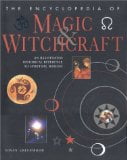 The Encyclopedia of Magic and Witchcraft: An Historical Exploration into the World of the Magician
The Encyclopedia of Magic and Witchcraft: An Historical Exploration into the World of the Magician
by Susan Greenwood
Little Brown, £17.95, ISBN 0754805816
This is a beautiful book, well-presented, with high quality paper, print and illustrations. The title is a bit misleading: it is not an encyclopaedia in the usual sense, where one can look up a certain subject. Instead, it is a collection of short chapters treating a wide variety of topics concerning magic and witchcraft from ancient times to today, across many civilisations. The author tries to define and describe magic, shamanism, occultism, and their relations with society and religion, and provides a lot of interesting information along the way. Since the scope is so wide not all subjects will appeal to all readers, but that goes for any encyclopaedia.
Some chapters are less informative, and the illustrations can even be irritating because many have but little relevance to the subject. As a reader of an encyclopaedia one does not draw much information about the Greco-Roman or the Celtic period from reproductions from paintings by 18th to 20th century European artists, unless one accepts that this book is more intended as entertainment.
Another uneasy feeling came to me as a skeptic when I started to realize that the author is writing in defence of magic and really believes in it; and often the limit between objective data and the personal beliefs of the author is not well-defined. Some topics are treated too narrowly or are one sided, such as the small chapter called “Science and Magic”. The scientific view is represented only by one philosopher and two anthropologists.
The personal view of Greenwood on this subject sounds peculiar: “Magic is similar to science. It also offers an explanation of the world although it uses the medium of spiritual connection that cannot be measured in a laboratory.
The cause effect relation in spiritual Magic and science are different ways of thinking. All humans can exercise two ways of thinking: logical analytical and analogical or magical . . . both can be examined and understood through a scientific world view.”
This kind of threw me off, but then there followed some very good texts on famous witches and witchhunts, although with many illustrations that certainly have aesthetic value but provide no information on the subject.
When discussing astrology, the author laments that the link unifying the individual with the cosmos has been lost, and also states that the elixir of immortality was invented in China in the 4th century BC. Again it gave me a von Däniken feeling and it made me wonder how much all the other information can be trusted.
Do I recommend this book? I don’t know – it depends what you are looking for. It certainly is entertaining, and nice to have on the coffee table, not least for the illustrations. Some parts are very good and others are less so, but all are pleasant to the eye. Perhaps I should not have taken the title too literally.



